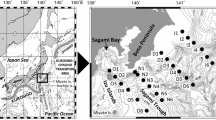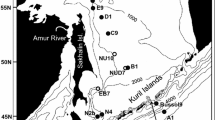Abstract
In the present study, we used a 3D Coupled Ecosystem Model of Baltic Sea version 1 (3D CEMBSv1) coupled with a copepod model to examine the spatiotemporal distribution of two representative copepod populations in the Gulf of Gdansk (southern Baltic Sea) including Acartia spp. and Pseudocalanus minutus elongatus. The annual cycles simulated for 2000 under realistic weather and hydrographic conditions were studied with the three-dimensional version of the coupled ecosystem-copepod model in the south-eastern Baltic Sea. The paper presents the comparison of simulated and observed copepod development at two stations in the Gulf of Gdansk. A validation of influential state variables gives confidence that the model is able to calculate reliably the stage development of dominant species in the southern Baltic Sea. The number of generations was one for P. m. elongatus and 3–5 for Acartia spp.. A mean of five generations for the latter species per year were estimated in the coastal region and ca. three generations at the Gdansk Deep (in the open sea). Food concentration and temperature as the main factors controlling the development of the investigated copepods as well as salinity as a masking factor (i.e. salinity modifies the rate of their development) in the case of Pseudocalanus minutus elongatus are included in the present study.














Similar content being viewed by others
References
Ambler JW (1985) Seasonal factors affecting egg production and viability of eggs of Acartia tonsa Dana, from East Lagoon, Galveston, Texas. Estuar Costl Shelf Sci 20:743–760
Billen G, Lancelot C, Maybeck M (1991) N, P and Si retention along the aquatic continuum from land to ocean. In: Mantoura RFC, Martin JM, Wollast R (eds) Ocean margin processes in global change, physical, chemical, and earth sciences research, report 9. Wiley, New York, pp 19–44
Bollens SM, Frost BW (1989) Zooplanktivorous fish and variable diel vertical migration in the marine planktonic copepod Calanus pacificus. Limnol Oceanogr 34:1072–1083
Chojnacki J, Drzycimski I., Siudzinski K (1986) Charakterystyka ekologiczna ważniejszych skorupiaków planktonowych poludniowego Baltyku. Stud Mat MIR Gdynia A(27):5–24 (in Polish)
Ciszewski P (1962) Zooplankton of the Southern Baltic. Papers of MIR, Gdynia A(11):37–38 (in Polish)
Ciszewski P (1983) Estimation of zooplankton biomass and production in the Southern Baltic. Pol Ecol Stud 9:387–396
Ciszewski P, Witek Z (1977) Production of older stages of copepods Acartia bifilosa Giesb. and Pseudocalanus elongatus Boeck in Gdansk Bay. Pol Arch Hydrobiol 24:449–459
Dzierzbicka-Glowacka L (1994) Numerical analysis of the influence of the grazing on the two-dimensional distribution function of the phytoplankton concentration in a stratified sea. Oceanologia 36(2):155–173
Dzierzbicka-Glowacka L (2004) Growth and development of copepodite stages of Pseudocalanus spp. J Plankton Res 26:49–60
Dzierzbicka-Glowacka L (2005a) Equivalence of rates of growth and egg production of Pseudocalanus spp. Ocean Hydrobiol Stud 34(4):19–32
Dzierzbicka-Glowacka L (2005b) A numerical investigation of phytoplankton and Pseudocalanus elongatus dynamics in the spring bloom time in the Gdansk Gulf. J Mar Syst 53:19–36
Dzierzbicka-Glowacka L (2005c) Modelling the seasonal dynamics of marine plankton in the southern Baltic Sea. Part 1: a coupled ecosystem model. Oceanologia 47(4):591–619
Dzierzbicka-Glowacka L (2006) Modelling the seasonal dynamics of marine plankton in the southern Baltic Sea. Part 2: numerical simulations. Oceanologia 48(1):41–71
Dzierzbicka-Glowacka L, Bielecka L, Mudrak S (2006) Seasonal dynamics of Pseudocalanus minutus elongatus and Acartia spp. in the southern Baltic Sea (Gdansk Deep)—numerical simulations. Biogeosciences 3:635–650
Dzierzbicka-Glowacka L, Lemieszek A, Zmijewska IM (2009a) Parameterization of a population model for Acartia spp. in the southern Baltic Sea. Part 1: development time. Oceanologia 51(2):165–184
Dzierzbicka-Glowacka L, Lemieszek A, Żmijewska IM (2009b) Parameterization of a population model for Acartia spp. in the southern Baltic Sea. Part 2: egg production. Oceanologia 51(2):185–201
Dzierzbicka-Glowacka L, Zmijewska IM, Mudrak S, Jakacki J, Lemieszek A (2010) Population modelling of Acartia spp. in a water column ecosystem model for the South-Eastern Baltic Sea. Biogeosciences 7:2247–2259
Dzierzbicka-Glowacka L, Jakacki J, Janecki M, Nowicki A (2011) Variability in the distribution of phytoplankton as affected by changes to the main physical parameters in the Baltic Sea. Oceanologia 53(1-TI):449–470
Frost BW (1989) A taxonomy of the marine calanoid copepod genus Pseudocalanus. Can J Zool 67:525–551
Goodkin NF, Hughen KA, Doney SC, Curry WB (2008) Increased multidecadal variability of the North Atlantic Oscillation since 1781. Nat Geosci 1:844–848
HELCOM (2003) The Baltic marine environment 1999–2002. In: Baltic Sea environment proceedings
HELCOM (2005) Nutrient pollution to the Baltic Sea in 2000. In: Baltic Sea environmental proceedings
HELCOM (2006) Development of tools for assessment of eutrophication in the Baltic Sea. Baltic Sea environmental proceedings
Hernroth L (1985) Recommendations on methods for marine biological studies in the Baltic Sea. Mesozooplankton biomass assessment. Balt Mar Biol 10:1–32
Katajisto T (2006) Benthic resting eggs in the life cycles of calanoid copepods in the northern Baltic Sea. W. & A. de Nottbeck Foundation Sci Rep 29:1–46
Kinne O (1963) The effects of temperature and salinity on marine and brackish water animals. I. Temperature. Oceanogr Mar Biol Ann Rev 1:301–340
Klein Breteler WCM, Gonzales SR, Schogt N (1995) Development of Pseudocalanus elongatus (Copepoda, Calanoida) cultured at different temperature and food conditions. Mar Ecol Prog Ser 119:99–110
Kleppel GS, Holliday DV, Pieper RE (1991) Trophic interactions between copepods and microplankton: a question about the role of diatoms. Limnol Oceanogr 36:172–178
Kleppel GS (1992) Environmental regulation of feeding and egg production by Acartia tonsa off southern California. Mar Biol 112:57–65
Koszteyn J (1985) Wertykalne zróżnicowanie skladu jakościowego i ilościowego mezoplanktonu w wodach Basenu Gdańskiego i Rynny Slupskiej w lipcu 1980 roku. Stud Mater Oceanol 46(7):193–212 (in Polish)
Krause M, Dippner JW, Beil J (1995) A review of hydrographic controls on the distribution of zooplankton biomass and species in the North Sea with particular reference to a survey conducted in January–March 1987. Prog Oceanogr 35:81–152
Longhurst AR, Harrison WG (1989) The biological pump: profiles of plankton production and consumption in the upper ocean. Prog Oceanogr 22:47–123
Longhurst AR (1981) Analysis of marine ecosystems. Academic, London
Longhurst AR (2007) Ecological geography of the sea. Academic, London
Majewski A (1990) Morfometria i hydrografia zlewiska. In: Majewski A (ed) Zatoka Gdańska. Wydawnictwo Geologiczne, Warszawa, pp 10–19 (in Polish)
Mankowski W (1978) Baltic zooplankton and its productivity. Productivity of Baltic sea ecosystem. Ossolineum, Wroclaw–Warszawa–Kraków–Gdansk, pp 113–134
McLaren IA, Leonard A (1995) Assessing the equivalence of growth and egg production of copepods. ICES J Mar Sci 52:397–408
McLaren IA, Sevigny J-M, Cockett CJ (1989) Temperature-dependent development among Pseudocalanus species. Can J Zool 67:559–564
Möllmann C, Kornilovs G, Sidrevics L (2000) Long-term dynamics of main mesozooplankton species in the Central Baltic Sea. J Plankton Res 22:2015–2038
Mudrak S (2004) Short- and long-term variability of zooplankton in coastal Baltic waters: using the Gulf of Gdańsk as an example. PhD thesis, University of Gdansk, Gdynia
Mudrak S, Zmijewska MI (2007) Spatio-temporal variability of mesozooplankton from the Gulf of Gdańsk (Baltic Sea) in 1999–2000. Oceanol Hydrobiol Stud 36:3–19
Norrbin MF (1996) Timing of diapause in relation to the onset of winter in the high- latitude copepods Pseudocalanus acuspes and Acartia longiremis. Mar Ecol Prog Ser 142:99–109
Ojaveer E, Alken J (1997) On regional subunits in the ecosystem of the Baltic Sea. In: Proceedings of the 14th BMB Symposium, pp 156–169
Postel L (2005) Habitat layer extension and the occurrence of dominant calanoid copepods in the Baltic Sea. http://www.helcom.fi/environment2/ifs/archive/ifs
Radach G, Moll A (1993) Estimation of the variability of production by simulating annual cycles of phytoplankton in the central north Sea. Prog Oceanogr 31:339–419
Renk H (2000) Primary production in the southern Baltic. Sea Fisheries Institute in Gdynia, Stud Mater 3(A), p 78 (in Polish)
Renz J, Hirche H-J (2006) Life cycle of Pseudocalanus acuspes Giesbrecht (Copepoda, Calanoida) in the Central Baltic Sea: I. Seasonal and spatial distribution; Mar Biol 148:567–580
Renz J, Peters J, Hirche H-J (2007) Life cycle of Pseudocalanus acuspes Giesbrecht (Copepoda, Calanoida) in the Central Baltic Sea: II. Reproduction, growth and secondary production. Mar Biol 151:515–527
Reissmann JH, Burchard H, Feistel R, Hagen E, Lass HU, Mohrholz V, Nausch G, Umlauf L, Wieczorek G (2009) Vertical mixing in the Baltic Sea and consequences for eutrophication—a review. Prog Oceanogr 82:47–80
Rozwadowska A, Isemer H-J (1998) Solar radiation fluxes at the surface of the Baltic Proper. Part 1: mean annual cycle and influencing factors. Oceanologia 40:307–330
Schmidt K, Kähler P, Bodungen B (1998) Copepod egg production rates in the Pomerania Bay (southern Baltic Sea) as a function of phytoplankton abundance and taxonomic composition. Mar Ecol Prog Ser 174:183–195
Sekiguchi H, McLaren IA, Corkett CJ (1980) Relationship between growth rate and egg production in the copepod Acartia clausi Hudsonica. Mar Biol 58:133–138
Shaffer G (1987) Redfield rations, primary production and organic carbon burial in the Baltic Sea. Deep Sea Res 34:769–784
Skura SP (2003) Gopepoda in the Gdańsk deep (June 2001). PhD thesis, University of Gdańsk, Gdynia
Stegert C, Kreus M, Carlotti F, Moll A (2007) Parameterisation of a zooplankton population model for Pseudocalanus elongatus using stage duration laboratory experiments. Ecol Model 206:214–234
Telesh I, Postel L, Heerkloss R, Mironova E, Skarlato S (2009) Zooplankton of the open Baltic Sea: extended atlas. BMB publication no. 21—Meereswiss. Ber. Warnemünde 76:1–290
Viitasalo M (1992) Calanoid resting eggs in the Baltic Sea: implications for the population dynamics of Acartia bifilosa (Copepoda). Mar Biol 114:397–405
Vinogradow ME, Shushkina EA (1987) Functioning of plankton communities in the euphotic zone of the ocean. Nauka, Moskwa (in Russian)
Voipio A (1981) The Baltic Sea. Elsevier, Amsterdam, pp 123–143
Wiktor K (1982) Wpływ metody zbioru zooplanktonu wód przybrzeżnych Bałtyku Południowego na wyniki analiz jakościowych i ilościowych. Oceanography 9:93–109 (in Polish)
Wiktor K (1990) Zooplankton biomass in the coastal waters of Gdańsk Gulf. Oceanography 12:109–134 (in Polish)
Witek Z (1995) Biological production and its utilization within a marine ecosystem in the western Gdansk basin. Sea Fisheries Institute, Gdynia, Poland, pp 145 (in Polish)
Witek Z, Bralewska J, Chmielewski H, Drgas A, Gostkowska J, Kopacz M, Knurowski J, Krajewska-Sołtys J, Lorenz Z, Maciejewska K, Mackiewicz T, Nakonieczny J, Ochocki S, Warzocha J, Piechura J, Renk H, Stopiński M, Witek B (1993) Structure and function of marine ecosystem in the Gdańsk Basin on the basis of studies performed in 1987. Stud Mater Oceanol 63:5–125
Acknowledgments
This work was supported by the Polish State Committee of Scientific Research (grant number: NN306 353239).
Author information
Authors and Affiliations
Corresponding author
Rights and permissions
About this article
Cite this article
Dzierzbicka-Glowacka, L., Piskozub, J., Jakacki, J. et al. Spatiotemporal distribution of copepod populations in the Gulf of Gdansk (southern Baltic Sea). J Oceanogr 68, 887–904 (2012). https://doi.org/10.1007/s10872-012-0142-8
Received:
Revised:
Accepted:
Published:
Issue Date:
DOI: https://doi.org/10.1007/s10872-012-0142-8




